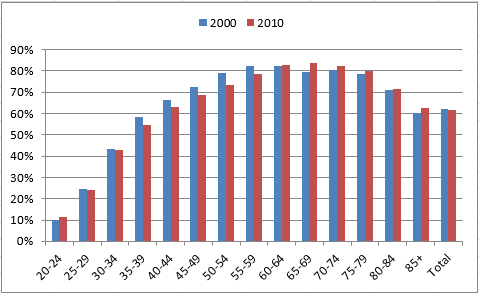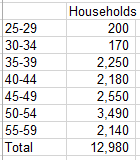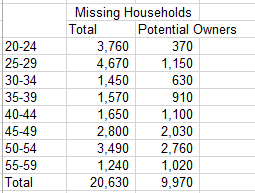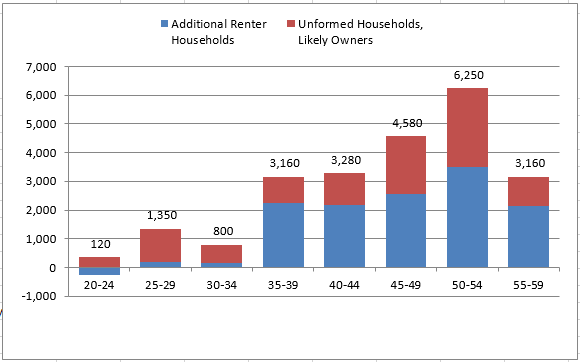Who is Missing from the Ownership Market?
Nationally, U.S. Census Bureau data shows that the homeownership rate has fallen to a 48-year low, and household formation has slowed, diminishing the overall demand for housing.
The Recession strained budgets and many changed their living situations in response: adult children remained in their parents' homes and parents moved in with their adult children. The subsequent slow-down in household formation led to "missing households," or households that were unformed largely because of economic circumstances. According to Federal Reserve Bank of Cleveland estimates, there may have been as many as 2.6 million unformed households in 2010 compared to pre-recession conditions.
The increase in renter-households and the doubling-up of households has had a significant effect on the existing home sales market nationwide. Although the Washington-area economy fared better than the nation's, similar trends have been seen here. In the NVAR region, the homeownership rate decreased by 0.5 percentage points between 2000 and 2010, and there may have been as many as 20,630 unformed households. Together, these factors resulted in an estimated 22,700 fewer owner-households in the NVAR region in 2010. Of these would-be owners, the majority were not Millennials, but were between 35 years old and 59 years old.
HOMEOWNERSHIP RATES
Figure 1: Homeownership Rates by Age of Householder, 2000 and 2010

In 2000, 62.3 percent of all households in the NVAR region were homeowners. In 2010, the homeownership rate had decreased 0.5 percentage points to 61.8 percent (Figure 1). While the overall decline is modest, the decrease for younger households is more pronounced and is offset by increases for older households (Figure 1).
Source: U.S. Census Bureau (2000 and 2010 Census, microdata)
Figure 2: Percentage Point Change in Homeownership Rates by Age of Householder, 2000 to 2010

Figure 2 shows the percentage point difference in the homeownership rates in 2000 and 2010 by the age of the head of the household. Of the age groups, householders between 50 and 54 years old had the sharpest decrease in their homeownership rate, falling 6 percentage points. Four age groups had homeownership rates that were 4 percentage points lower in 2010 than in 2000: 35-39 years old, 40-44 years old, 45-49 years old, and 55-59 years old.
Source: U.S. Census Bureau (2000 and 2010 Census, microdata)
Which Age Groups are "Missing" Owners?
The decrease in the homeownership rate reflects a combination of preferences and economic circumstances which may not return to what they were in 2000. But for many, homeownership remains a goal. If homeownership rates in 2010 were equal to those in 2000 for select age groups, there would have been 12,980 additional owners in 2010 (Figure 3). This excludes all age groups with a higher homeownership rate in 2010 than in 2000, which consists mostly of older households.
Figure 3: Estimated Additional Renter Households, 2010

Source: U.S. Census Bureau (2000 and 2010 Census, microdata), and GMU Center for Regional Analysis
HOUSEHOLD FORMATION
Compared to 2000, fewer people between 20 and 59 years old were living in their own household in 2010. Unlike their younger counterparts, more people over 60 years old were living in their own household in 2010 than in 2000. Advances in healthcare, technology and other services have allowed older adults to remain independent for longer, a trend which is expected to continue.
"...[if] economic conditions were improved, it is likely that there would be highre rates of household formation."
In 2000, 66 percent of all 25-29 year olds were living in their own households compared to only 63 percent in 2010, a decrease of 3 percentage points. The decrease for 30-34 year olds was not as pronounced (-1 percentage point), but just as meaningful to the home sales market. Delayed household formation will also delay homeownership, resulting in fewer first-time home buyers in these age groups.
Instead of living in their own households, 15 percent of 25-29 year olds and 7 percent of 30-35 year olds were living with a parent or grandparent (Figure 4). Also, a larger share of both age groups was living with roommates in 2010 than in 2000. While this may enable them to save for a down-payment, student loans and weak job and wage growth have had a lasting impact on the finances of those in these age groups.
Figure 4: Share of People by Household Situation, 2000 and 2010

*Includes biological, adopted and step child, grandchild and son-in-law, daughter-in-law
**Includes biological or step parent, parent-in-law, or grandparent
***Includes the head of household, spouse or partner of head of household
Source: U.S. Census Bureau (2000 and 2010 Census, microdata)
What Age Groups are "Missing" Households?
Similar to homeownership, a person's living situation is driven by a combination of preferences and economic and/or employment situation. However, if economic conditions were improved, it is likely that there would be higher rates of household formation.
If household formation in 2010 followed 2000 patterns, there would have been 20,630 additional households in 2010 (Figure 5). This excludes people over 60 years old, who were more likely to live in their own households in 2010 than in 2000. Of these 20,630 households, an estimated 9,970 households would likely have been owners, based on the 2000 homeownership rates in for each age group.
Figure 5: Estimated Unformed Households by Age Group, 2010

Similar to the nation, there are many missing households from younger people in the NVAR region. But the number of older adults who are not living in their own household is also significant, because they traditionally have higher homeownership rates.
Source: U.S. Census Bureau (2000 and 2010 Census, microdata), and GMU Center for Regional Analysis
TOTAL "MISSING" OWNER-HOUSEHOLDS
The NVAR region had an estimated 22,700 fewer owner-households in 2010 than it would have had under pre-Recession conditions. In 2010, the oldest Millennials, those born between 1980 and 2000, would have been 30 years old, and account for just 6 percent of the total missing owner-households. Generation X, people born between 1965 and 1979, accounted for approximately one-third of the total (32 percent) and Baby Boomers, born between 1946 and 1964, accounted for approximately 62 percent of all missing owner-households.
Figure 6: Estimated Missing Owner Households by Age of Householder, 2010

Between 2010 and 2015, Millennials have become a larger force in the NVAR region's housing market because of their sheer number. Their tepid presence in the ownership market continues to be a concern. However, Generation X and the younger Baby Boomers should not be overlooked. Those groups also are not participating in the homeownership market as would be expected.
Source: U.S. Census Bureau (2000 and 2010 Census, microdata), and GMU Center for Regional Analysis
Due to the challenges in the labor market, a tight housing supply and overly stringent underwriting standards since the recession, homeownership rates have declined. The data shows that families have consolidated and the rental market remains strong locally. As consumer confidence increases, people may decide to enter the housing market, move up or downsize, and bring homeownership back to 2010 levels.
Jeannette Chapman is a research associate at the George Mason University Center for Regional Analysis.